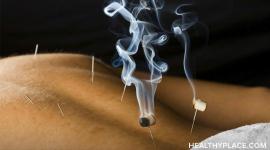Alternative Treatments for Alcoholism and Addiction

Alcoholics and addicts are turning to alternative and complementary treatments as an adjunct to traditional addiction treatment programs.
Bill Beilhartz had run out of options. In fact, he was close to death.
At age 44, the Denver father-of-two had just spent two weeks in the hospital for alcohol-induced ulcers in his esophagus and stomach. He'd registered a nearly lethal blood alcohol level of .675. He'd been through two failed marriages, and his tall, once-handsome frame was withered from years of drinking a half-gallon of vodka a day. Yet, his first stop after leaving the hospital? Incredibly, the liquor store.
Three days later, after being rushed to the hospital again—this time for internal bleeding—he began desperately flipping through the Yellow Pages looking for something beyond what his three previous treatment centers had offered—something that might actually work.
"They all had the same approach," says Beilhartz, an international casino consultant who had checked himself in each time before, paying as much as $10,000 per stay. "They tell you, 'Don't drink,' and that is pretty much the education they give you."
An ad for InnerBalance Health Center, a Colorado treatment program that takes a comprehensive holistic approach to addiction, jumped out at him. The clinic prescribed such treatments as nutritional counseling, intravenous vitamin therapy, yoga, and exercise programs. "It was different than anything I'd ever heard of. And it all just made sense to me," says Beilhartz, who checked in to the 35-day program in January 2006.
Months later, he's healthy, hopeful, and boasting more days of sobriety than in all the past 15 years combined. "Within a week of arriving, my mind was completely clear, and I felt energized and motivated to get on with life. I hadn't felt like that since my early 20s," he says.
Battling brain chemistry
Beilhartz is among a growing number of addicts and alcoholics turning toward complementary and alternative therapies to address the physiological underpinnings of addiction. The programs are rooted in the theory that addiction is largely the result of skewed levels of certain chemical messengers in the brain.
With too much of some messengers and not enough of others, researchers believe, addicts are caught—often from childhood—in a state of chronic imbalance and turn to drugs and alcohol to self-medicate in an attempt to feel "normal."
Most addiction experts agree that talk therapy and 12-step programs—considered the gold standard for addiction treatment for decades—are a necessary component of a successful recovery. But in and of themselves, such methods have not proven terribly effective. Between 70 and 85 percent of addicts completing such programs will relapse within six to 12 months, studies show. Meanwhile, some alternative clinics that incorporate both physiological and psychological approaches boast six-month sobriety rates as high as 85 percent.
"If you have a broken leg and your bone is sticking out, you aren't going to want to sit around and talk about it. You are going to want to go to the emergency room, fix the physical problem, and stop the pain first," explains Joe Eisele, clinical director of InnerBalance and a recovering alcoholic. "Then you can sit down and talk."
Reward deficiency syndrome
The notion that addiction is a biochemical disease dates back to the late 1980s when Texas brain researcher Kenneth Blum coined the phrase "reward deficiency syndrome." Blum theorized that for most people, the stimulus of everyday things like good food, sex, or a funny movie set off a cascade of feel-good neurotransmitters in the brain. But some people are born with either an inability to produce enough of these chemicals or a kink in the line that delivers them. For such individuals, the cascade of reward is hindered and pleasure muted, if it comes at all.
"Addicts are always looking for a way to feel better, and when they discover certain mood-altering substances—those things that fit into the same receptors in the brain that the deficient 'feel-good' chemicals do—they feel like they are getting what they have been looking for but have never been able to find," says Merlene Miller, an addictions specialist and coauthor of the book Staying Clean and Sober: Complementary and Natural Strategies for Healing the Addicted Brain (Woodland, 2005).
Today, experts readily accept the notion that faulty brain chemistry plays a role in setting people up for addiction, but for the most part, addiction researchers have focused on correcting that brain chemistry with pharmaceuticals, rather than addressing it more holistically. Meanwhile, more and more clinics around the country use that same information to take a different, more holistic approach.
Vitamins through a tube
Step into InnerBalance Health Center on any given Wednesday and you'll find a room full of resident patients, from grandmothers trying to quit binge drinking to musicians who want to kick cocaine. They're watching videos and chatting as orange liquid drips into their veins through intravenous tubes.
Alcoholism and drug abuse can ravage the gastrointestinal system, limiting its ability to absorb nutrients, so pumping vitamin C, calcium, magnesium, zinc, and B vitamins directly into the blood has a more immediate effect than administering them orally, says Eisele. And because underlying nutritional problems, such as hypoglycemia or B-vitamin deficiencies, often prompt cravings, IV therapy can often quell the withdrawal that leads addicts to relapse early on.
At Bridging the Gaps Inc. in Winchester, Virginia, patients begin treatment with a series of blood and urine tests to assess their liver and kidney function and nutritional status. They also fill out a psychological survey to determine if they might be lacking in certain brain chemicals. They then receive a customized cocktail of nutrients and amino acids—the building blocks for neurotransmitters—through an IV tube for six to 10 days.
The amino acid given depends on which neurotransmitter appears to be lacking. For example, clinic staff members presume that addicts who prefer sedatives or alcohol lack the calming neurotransmitter GABA, so they give them its amino acid precursor. Someone who gravitates toward drugs like cocaine, on the other hand, would get amino acids that stimulate excitatory activity in the brain.
James Braly, MD, medical director and attending physician at Bridging the Gaps, says the medical journals have published few studies about the benefits of IV and oral nutrient therapy specifically, largely because most research dollars support pharmaceutical approaches to treating addiction. But Braly's clinic has produced some promising data. One study surveyed newly sober patients about the severity of 15 "abstinence symptoms" (such as cravings, anxiety, depression, insomnia, fuzzy thinking, and restlessness) both before and after six days of IV and oral nutrition therapy. It found that all 15 symptoms were radically reduced, making it easier for the patient to stick with the psychosocial counseling part of the program.
Once the body is better able to absorb nutrients and the brain chemistry is rebalanced, patients are placed on a daily regimen of oral vitamins, amino acids, essential fatty acids, and probiotics. At the same time, they receive nutritional counseling aimed at steering them toward lots of fresh fruits and vegetables; quality proteins such as fish, poultry, and eggs; and nutritional oils such as extra virgin olive oil and omega-3 fish oils. They are strongly urged to stay away from junk food and refined carbohydrates, which can cause blood sugar to fluctuate wildly, aggravating cravings.
Such nutritional approaches stem largely from the work of Joan Matthews Larsen, whose groundbreaking book Seven Weeks to Sobriety: The Proven Program to Fight Alcoholism With Nutrition (Ballantine, 1997) sparked many people to open clinics based on her Health Recovery Center in Minneapolis. One published study conducted there found that 85 percent of clients had remained sober six months after treatment. After three and a half years, 74 percent were still sober.
Another success story, Ty Curan, 29, a recovering heroin addict, experienced dramatic results by changing his diet and adding a supplement regime. A drug user since the age of 15, he had completed nine residential in-patient treatment programs before checking in to Bridging the Gaps in December 2005. "I would go to treatment for a month, stay clean for a month, and fall back apart," he recalls. The difference this time, he says, is after his stay at Bridging the Gaps, he's been able to stay sober: "It truly is the best I've felt in a long, long time."
Needling the ear
Another key component at Bridging the Gaps is ear acupuncture—now being used in more than 800 federally recognized addiction programs across the country.
Chinese medicine practitioners discovered more than 2,500 years ago that when they manipulated certain points in the ear, they could relieve the discomfort of people going through opium withdrawal. In the 1970s, a neurosurgeon in Hong Kong revived the practice after noting that when he delivered electrical stimulation to a certain acupuncture point in the ear for post-surgical pain relief, he also alleviated his patient's opiate withdrawal symptoms.
When word of the treatment made it to the US, the practice took off here, ultimately evolving into a protocol that calls for five needles placed in ear points said to regulate the nervous system, cerebral cortex, respiratory system, liver, and kidneys. Today, the nonprofit National Acupuncture Detoxification Association teaches the method worldwide, and the federal government has granted millions of dollars to study its efficacy.
Research has produced mixed results, but some studies have shown this method of ear acupuncture can not only quell withdrawal symptoms in notoriously hard-to-treat heroin and cocaine addicts, but it has the added benefit of helping people stick with a treatment program.
For the past 30 years, Michael Smith, MD, director of the Recovery Center at Lincoln Hospital in the Bronx, New York, has offered ear acupuncture to addicts awaiting methadone therapy for heroin and cocaine addiction at the clinic.
He began to see results immediately. "This one woman took the treatment, and after about five minutes, her nose stopped running, and she looked more comfortable. About a half hour later she said, 'I'm hungry. I want to eat something,'" recalls Smith. "No heroin addict in the middle of withdrawal has ever said, 'I want to eat something.' She ate a double helping." Even more remarkable, she also left without the methadone and returned the next day for another acupuncture treatment instead. Five years later, the clinic stopped offering methadone therapy altogether. Now, it treats as many as 50 patients at a time with ear acupuncture, upping the chances that they will return for counseling. "You start it as soon as they arrive because it helps people when they are in crisis," says Smith.
While ear acupuncture is by far the most researched form of needling for addiction treatment, traditional Chinese acupuncture, which uses points all over the body, can also play an important role—particularly for pain relief.
Studies show acupuncture relieves pain effectively, which makes it ideal for people trying to wean themselves off prescription pain killers, and it can also help people deal with chronic health problems resulting from years of drug and alcohol abuse.
At Bridging the Gaps Inc. in Winchester, Virginia, patients begin treatment with a series of blood and urine tests to assess their liver and kidney function and nutritional status. They also fill out a psychological survey to determine if they might be lacking in certain brain chemicals. They then receive a customized cocktail of nutrients and amino acids—the building blocks for neurotransmitters—through an IV tube for six to 10 days.
Don't stress out
Once the body has begun to heal, keeping stress at bay becomes a critical factor in continued progress. Many clinics across the country offer classes in meditation and yoga and also mandate a regular exercise program. But some have also begun to look toward a more novel approach to stress reduction called brain wave, or EEG, biofeedback, a computer-assisted relaxation technique that helps patients learn to manipulate their own brain waves. Research has shown that prolonged drug use can actually alter brain wave activity, prompting mental sluggishness or agitation depending on the substance used.
"It's almost like the brain is misfiring because [recovering addicts] have been using these drugs, and biofeedback helps them learn how to make it fire properly," says Don Theodore, a certified addictions specialist who runs the brain wave biofeedback program at Cri-Help Inc. in Hollywood, California.
For 45 minutes twice a day, clients lie in a comfortable chair with brain wave-charting sensors attached to their heads. As they make their way through visualization and relaxation exercises, a tone in their ear "rewards them" when they reach alpha and theta brain wave states, which are associated with calm and openness. So far, the research is promising. In one 2005 study, addicts who underwent 40 to 50 biofeedback sessions, along with counseling, were far less likely to drop out of treatment; after 12 months, 77 percent were still clean.
Pulling it all together
Back at InnerBalance in Colorado, Beilhartz credits a combination of things for his long-sought recovery. The IV vitamin therapy and supplements certainly helped him get through the initial cravings, both the nutritional counseling and the mandatory three-day-a-week exercise class helped him recover his health, and the group counseling provided much-needed peer support.
As a result, he recently left his job in the casino business and is now preparing to go back to school. His future plans: to become an addictions counselor specializing in a holistic approach.
"I spent the last 44 years thinking only of myself. I'd like to spend the next 44 years returning favors and taking care of people," he says. "These guys are amazing. This place is amazing."
Eating right to kick the habit
- Lay off the sugar. Once alcoholics quit the bottle, they gravitate toward the sugar bowl, which can be disastrous. The high they get from sugar leads to a crash, a mood slump, and a subsequent craving—for alcohol, drugs, or more sugar.
- Reach for whole grains. To break the cycle, choose raw or lightly cooked fruits and veggies, exchange white rice for brown, and eat oatmeal for breakfast.
- Snack on protein. To keep blood sugar at an even keel, eat a healthy protein snack, like hard-boiled eggs, chunks of cheese, nuts, or peanut butter and apples, every two or three hours.
Alternative Treatment Resources
InnerBalance Health Center
2362 E. Prospect Rd., Suite B
Fort Collins, CO 80525
877.900.QUIT
www.innerbalancehealthcenter.com
Bridging the Gaps Inc.
423 W. Cork St.
Winchester, VA 22601
540.535.1111
www.bridgingthegaps.com
Health Recovery Center
3255 Hennepin Ave. South
Minneapolis, MN 55408
612.827.7800
www.healthrecovery.com
Cri-Help Inc.
11027 Burbank Blvd.
North Hollywood, CA 91601
818.985.8323.
www.cri-help.org
Source: Alternative Medicine
APA Reference
Staff, H.
(2008, October 12). Alternative Treatments for Alcoholism and Addiction, HealthyPlace. Retrieved
on 2025, April 20 from https://www.healthyplace.com/alternative-mental-health/addictions/alternative-treatments-for-alcoholism-and-addiction



